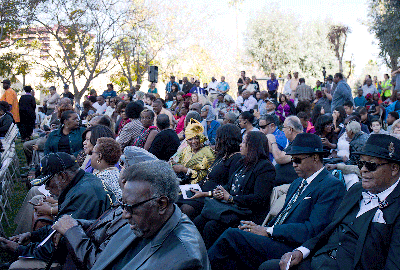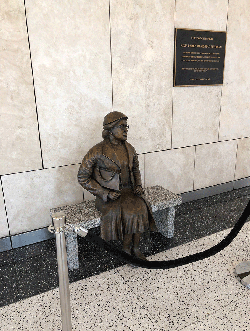The crowd looks on as the Rosa Parks statue unveiling ceremony unfolds in San Bernardino. Photo by District 8 
By David Matza
Caltrans District 8 Government and Legislative Affairs Liaison
Rosa Parks is finally home.
On Feb. 2, a decade-long journey to memorialize the life and legacy of civil rights icon Rosa Parks in the Inland Empire was finally completed with the unveiling of a bronze statue in her honor.
The journey to this historic unveiling was not an easy one, requiring a great deal of hard work and perseverance from a large group of dedicated individuals determined to bring the statue to San Bernardino. Those who worked to ensure the success of this significant monument, knew that this was just not another statue, but a symbol of hope and inspiration for an entire community.
Joe Baca Jr., who represented the city of San Bernardino in the State Assembly in 2008, was the driving force behind this endeavor; authoring Assembly Concurrent Resolution (ACR) 107, which renamed the San Bernardino State Building the Rosa Parks Memorial Building. Though this was a tremendous feat, it was just the beginning of the journey to cementing Rosa Park’s legacy in San Bernardino.
The idea for the Rosa Parks statue first came to local artist Patrick Jewett in 1991 when he witnessed Rosa Parks herself participating as the Grand Marshall of the Black History Parade in San Bernardino. When Jewett learned that the state building in San Bernardino would be named after Rosa Parks, he knew that his statue would have a home.
The only thing standing in the way of his vision to commemorate the life of Rosa Parks from happening was raising the $39,000 required to complete the bronze statue, along with the marble bench that Rosa Parks would sit upon. To meet this need, many members of the community came together to raise the funds and bring awareness to this historic endeavor.
The San Bernardino Black Culture Foundation, in conjunction with Caltrans, worked together to reach out to every community group in the area, contacting people from all walks of life to get the funding that was needed. And they were successful.
Donations came from various sources in all amounts. The city of San Bernardino gave a generous donation in the form of a grant, and personal contributions came from local Inland Empire residents who wanted to have a part in bringing the statue to their community. Unfortunately, more was needed to bring this vision and local effort to completion.
Assembly Member Eloise Gomez-Reyes, who now represents the city of San Bernardino in the State Assembly, helped get the project over the finish line. Through her tireless advocacy, Assembly Member Gomez-Reyes was able to secure the final $15,000 needed to complete the statue with funding from the State of California.
After the statue was under construction, all that was left was to bring the community together to celebrate the life and legacy of Rosa Parks, and establish the permanent reminder of her contribution to a more equal society at the Rosa Parks Memorial Building.

The Rosa Parks statue looks upon its new home at the Caltrans District 8 office, now known as the Rosa Parks Memorial Building.
Photo by District 8
Caltrans employee Antonio Hebb stepped up to lead the unveiling ceremony. Hebb had already been heavily involved in the project since its inception and was pivotal in raising the funds needed to get the statue made. Hebb assembled a committee that included representatives from the San Bernardino Black Culture Foundation, Caltrans employees and representatives from Assembly Member Eloise Gomez-Reyes’s office.
The committee planned the unveiling and decided on the theme of, “Live Life as a Model for Others,” which was a quote from Rosa Parks and words that she lived by daily. This quote has special meaning to Caltrans as one of our main values that we follow is “Model the Way.”
Once the theme of the event was set, it was time to decide on who would relay the message of the event in a powerful and meaningful way. The speakers included local dignitaries and pillars of the Inland Empire community. Speakers included Margaret Hill, a school board member for the San Bernardino Unified School District and tireless advocate for the youth of the Inland Empire who, in addition to Assembly Member Gomez-Reyes was pivotal in making the statue a reality. Also speaking was Congressman Pete Aguilar, who represents the city of San Bernardino, and State Senator Connie Leyva representing the city of San Bernardino and who has an office in the Rosa Parks Memorial Building.
The person who everyone was most eager to hear from, though, was Elaine Steele. Mrs. Steele was a close friend and lifelong companion of Rosa Parks. The crowd was silent and attentive to every word during her brief but powerful speech.
Then Caltrans Director Malcolm Dougherty also attended and welcomed the more than 800 attendees. He made sure that the audience knew that this ceremony was more than just the unveiling of a statue. Dougherty stated, “But her heart, spirit, and courage do not reside in marble concrete; they reside in the hearts and minds of all of us who continue to follow the legacy that she left behind.”
Although the ceremony has now passed, the statue and the building that it resides in, will serve as a permanent reminder of Rosa Parks’ unparalleled contribution to our society. Her statue will forever remind us of the power of “community” found when people come together to serve and help one another.
Yes, Rosa Parks is finally home.

